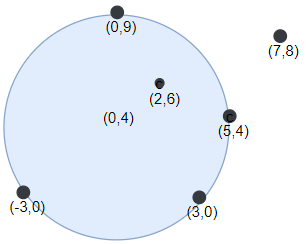圆形靶内的最大飞镖数量
难度:
标签:
题目描述
Alice is throwing n darts on a very large wall. You are given an array darts where darts[i] = [xi, yi] is the position of the ith dart that Alice threw on the wall.
Bob knows the positions of the n darts on the wall. He wants to place a dartboard of radius r on the wall so that the maximum number of darts that Alice throws lie on the dartboard.
Given the integer r, return the maximum number of darts that can lie on the dartboard.
Example 1:

Input: darts = [[-2,0],[2,0],[0,2],[0,-2]], r = 2 Output: 4 Explanation: Circle dartboard with center in (0,0) and radius = 2 contain all points.
Example 2:

Input: darts = [[-3,0],[3,0],[2,6],[5,4],[0,9],[7,8]], r = 5 Output: 5 Explanation: Circle dartboard with center in (0,4) and radius = 5 contain all points except the point (7,8).
Constraints:
1 <= darts.length <= 100darts[i].length == 2-104 <= xi, yi <= 104- All the
dartsare unique 1 <= r <= 5000
代码结果
运行时间: 109 ms, 内存: 17.6 MB
/*
* 思路:
* 1. 枚举每两个飞镖位置的组合,计算它们的几何中点作为圆心
* 2. 计算该几何中点距离两点的距离,确保它在半径范围内
* 3. 使用此圆心和半径计算在圆内的飞镖数量
* 4. 返回最大数量
*/
import java.util.*;
import java.util.stream.*;
public class DartboardStream {
public int numPoints(int[][] darts, int r) {
int n = darts.length;
return IntStream.range(0, n).boxed()
.flatMap(i -> IntStream.range(i + 1, n)
.mapToObj(j -> new int[][]{darts[i], darts[j]}))
.filter(pair -> Math.hypot(pair[0][0] - pair[1][0], pair[0][1] - pair[1][1]) <= 2 * r)
.flatMapToInt(pair -> IntStream.of(0, 1).map(k -> {
double midX = (pair[0][0] + pair[1][0]) / 2.0;
double midY = (pair[0][1] + pair[1][1]) / 2.0;
double angle = Math.atan2(pair[1][1] - pair[0][1], pair[1][0] - pair[0][0]);
double offset = Math.sqrt(r * r - (Math.hypot(pair[0][0] - pair[1][0], pair[0][1] - pair[1][1]) / 2) * (Math.hypot(pair[0][0] - pair[1][0], pair[0][1] - pair[1][1]) / 2));
double centerX = midX + offset * Math.cos(angle + (k == 0 ? Math.PI / 2 : -Math.PI / 2));
double centerY = midY + offset * Math.sin(angle + (k == 0 ? Math.PI / 2 : -Math.PI / 2));
return (int) Arrays.stream(darts)
.filter(dart -> Math.hypot(dart[0] - centerX, dart[1] - centerY) <= r)
.count();
}))
.max()
.orElse(1); // 至少一个飞镖在圆内
}
public static void main(String[] args) {
DartboardStream db = new DartboardStream();
int[][] darts = {{-2, 0}, {2, 0}, {0, 2}, {0, -2}};
int r = 2;
System.out.println(db.numPoints(darts, r)); // 输出4
}
}解释
方法:
这道题的解决方案使用了角度扫描的方法。首先,对于每个点,计算它与其他所有点之间的角度,如果两点之间的距离小于等于直径,则这两点可以由同一个圆覆盖。基于这两点之间的中点和向量方向,我们可以计算出两个角度——入圈和出圈的角度。将这些角度事件存储起来,并进行排序。排序后,通过遍历这些角度事件,并用一个计数器来追踪当前圆内飞镖的数量,就可以找到最多的飞镖数量。通过比较所有点作为圆心时的最大值,得到最终答案。
时间复杂度:
O(n^3 log n)
空间复杂度:
O(n^2)
代码细节讲解
🦆
在计算两点之间的距离时,为什么要加上一个非常小的值`1e-8`?这对结果有什么影响?
▷🦆
为什么在处理角度事件时,需要将退出圆的事件设为负(`False`)?这样的设置有什么特定的理由或优势吗?
▷🦆
您提到的角度排序中使用了`lambda x: [x[0], -x[1]]`,这里为什么要对第二个元素使用负号进行排序?
▷